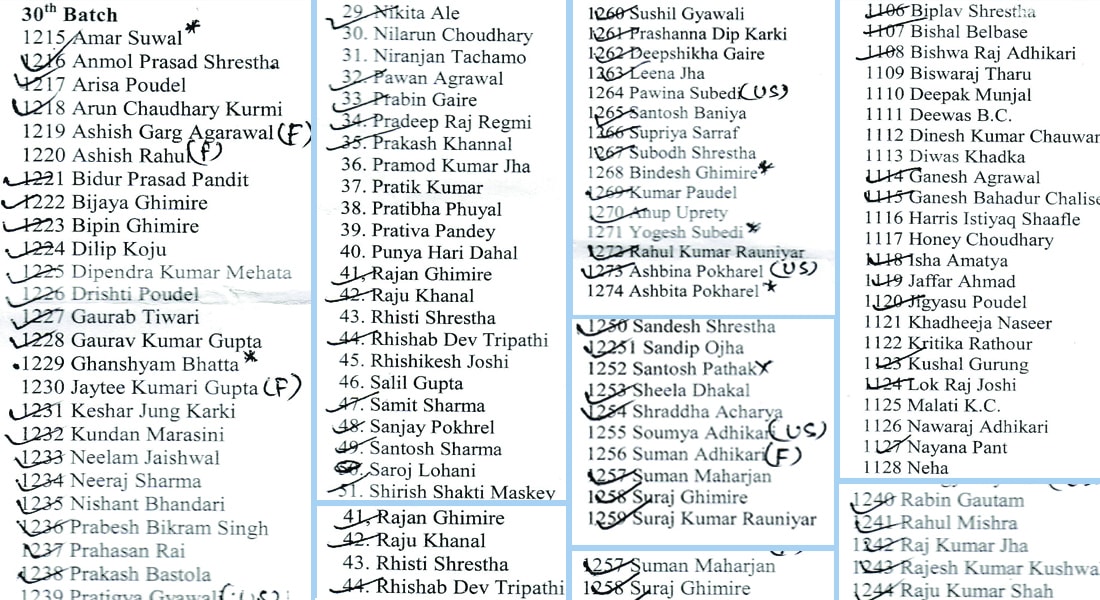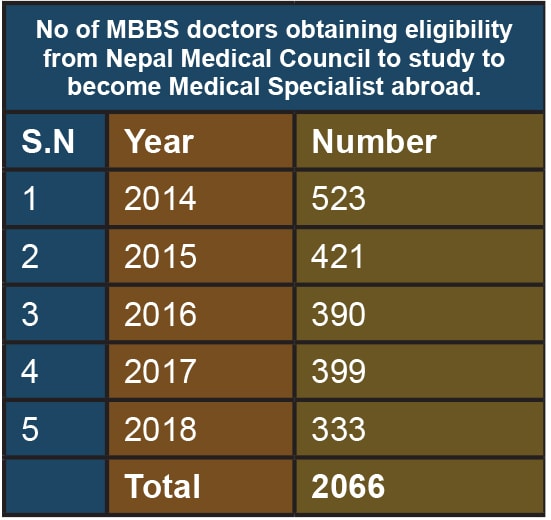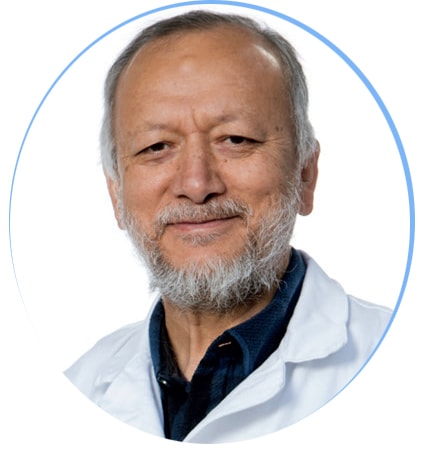After studying MBBS on government scholarship spending Rs 4 million, fresh graduates leave the country in the name of pursuing higher studies in a foreign land. An irony explained.
Pragya Timsina: Centre for Investigative Journalism-Nepal
It was the then King Birendra’s burning desire that sowed the seeds of medical studies in Nepal. If former Registrar at the Nepal Medical Council, Dr. Babu Ram Marasini’s statement is to be considered, King Birendra’s strong urge to introduce medical studies in the country was the result of his relentless effort to persuade foreigners to teach medical students here in Nepal.
“A fine morning of December 2034 BS, he reached the Maharajunj-based Institute of Medicine (IOM) and met Mohan Shah, the then IOM Dean,” Dr. Marasini goes down the memory lane to say that the then king was committed to introducing medical studies in the country. Dr. Marasini goes on to add, “He (Birendra) asked Shah when Nepal would produce its doctors?”

Thirty-nine doctors, around 87 percent, of the MBBS graduates of the 24th batch of IOM have been found to be in foreign countries.
An affirmative Shah responded that the medical studies would begin in six months. “Then, in 2035 BS, MBBS studies started in the country,” Dr. Marasini said.
MBBS studies in Nepal, according to Dr. Marasini, started with two major objectives. First, to ensure quality health service to the Nepali people by Nepali doctors; and secondly, to ensure that Nepalis need not persuade foreigners to come and teach medical studies in Nepal anymore.
The government then started making investments in medical studies after 2035 BS. Initially, the government invested around Rs 1 million on an MBBS student. In 2050 BS, the amount increased to Rs 1.5 million for each student. Currently, a medical student gets Rs 4 million to graduate. This means that the government has been investing around Rs 224 million to provide scholarships to a total of 56 students pursuing MBBS studies for the last several years. If the amount, including the salary and allowances of the teachers and staffers, and the grant received by hospitals under the IOM is gauged, the total expenditure comes to around Rs 3 billion a year.
60 percent abroad
Established to impart quality medical education in the country, the IOM has produced 38 batches of doctors so far, with the 39th batch preparing to graduate.

Source: Batch 1-22 British Medical Journal and 23-28 based on CIJ investigation.
The IOM produced, among others, 22 MBBS students on government scholarship in its first batch. Until the 28th batch, over 1,500 doctors have been produced from the IOM on a government scholarship.
However, according to research, out of these 1,500 students produced by IOM on substantial government funding, only 600 doctors — with the majority of them centered in Kathmandu — have been serving in the country.
For instance, the 24th batch of the IOM joined MBBS in 2059 BS and graduated after five years. In 2065 BS, after waiting for one complete year, they obtained the ‘passed out’ results. Eleven years down the line, among these 46 ‘passed out’ MBBS doctors, 87 percent of them (39 doctors) are currently out of the country in a foreign land.
Only seven doctors of the 24th batch including Dr. Anil Parajuli, Dr. Nisarika Shah, Dr. Pravesh Raj Niraula, Dr. Raj Babu Byanjankar, Dr. Sabin Koirala, Dr. Sushil Pakhrin Tamang and Dr. Prakash Karki are in Nepal now. “I, too, tried my luck to fly to America. I would have been in the United States now had everything went according to the plan,” said a doctor insisting anonymity.
A substantial number of MBBS graduates, who studied on government-scholarship before and after the 24th batch are out of the country. An article based on research published on a British journal in 2012 has elucidated the Nepali doctors’ desire after passing out from IOM.
The study jointly carried out by the IOM and British Medical Association, UK, on the 22 batches of IOM had concluded that around 40 percent of the Nepali doctors graduating on government scholarship has been serving in a foreign land – evidence of how those Nepali doctors studying on government sponsorship aspire to go abroad.
The investigation published in a journal did not rule out the possibility of new graduates from leaving the country in the years to come. Interestingly, the study carried out by the Center for Investigative Journalism (CIJ) comprising batches from the 23rd batch to the recent one at the IOM concurred with the eight-year-old research.
Strangely enough, if the number of students from batches 23 to 28 is considered, not more than 25 percent of the doctors are currently in Nepal. According to a CIJ investigation, about 75 percent of them are now out of the country serving in the United States, England, Canada, among others. (See Box)
The latest research is based on the conversation with doctors (of those batches) who are currently in Nepal after completing their MBBS, former and incumbent IOM officials, and office-bearers. The research showed that after 2075 BS, a substantial number of doctors graduating from IOM and that too on government funding are serving in a foreign country.
According to the research, while 62 percent of the 23rd batch of IOM students has left the country, the number rose to a staggering 87 percent in the 24th batch, the next year. Likewise, 65 percent of the 25th batch left the country, while 57 percent of batches 26 and 27 are serving in foreign lands, mainly the United States. Meanwhile, only 51 percent of the 28th batch of the MBBS studies have left the country.

Source: Nepal Medical Council
Besides IOM, BP Koirala Institute of Health Sciences (Dharan), Patan Academy of Health Sciences and some other private medical colleges impart medical studies on scholarship to an approximately 300 students under the Ministry of Education each year which means that the government spends a total of Rs 1.2 billion to this number of students with each getting a scholarship of Rs 4 million.
However, a lot of doctors completing their MBBS from the BP Koirala Institute of Health Sciences (Dharan) on rural quota scholarship have left the country and are practicing in foreign countries. However, the number is less in comparison to IOM pass outs. Out of the 64 MBBS students (from 4th to 20th batch) of BP Koirala Institute of Health Sciences (Dharan) on rural quota scholarship, 53 are practicing in Nepal.
Meanwhile, taking into consideration the brain-drain, the government has begun reining in doctors completing their MBBS on a government scholarship for the last six years.
The Ministry of Education and the Ministry of Health collaborated to introduce a mandatory rule that required doctors passing out their MBBS on government scholarship (from the 29th batch) to compulsorily serve in the country’s rural areas for at least two years. According to IOM Dean, Prof. Dr. Jagadiswor Agrawal, this rule did not apply to students until the 28th batch of IOM.
However, even after the implementation of this mandatory rule, seven doctors from the 29th batch and five from the 30th left the country and are working in foreign countries.
According to Dr. Sushil Gyawali, a pass out of the 29th batch, 12 doctors of these 29th and 30th batches are practicing in America by completing the US Medical Licensing Examination (USMALE). Moreover, 50 percent of the doctors from the same batches are in the process of acquiring a license in the United States.
If the applications to obtain recommendation letters for USMALE from the Ministry of Health are considered, a substantial number of doctors are preparing to sit for the examination. A doctor of the 31st batch of the IOM revealed that almost all the doctors of the batch are preparing to fly to the United States. However, the Ministry of Health has now halted issuing recommendations raising doubts over their intention of whether they would return to the country. Doctors of the 32nd and 33rd batches are now practicing in Nepal as per the government’s mandatory rule of serving in the country for at least two years. The students of 34th to 39th batches are in the process of completing their MBBS.
America, the most preferred destination

Photo: Hams Hospital, Kathmandu
Hospitals are books and patients teachers for a doctor.
Prof. Dr. Arjun Karki, former Vice Chancellor of Patan Health Sciences Academy. He is also the gold medalist of the 2nd batch of IOM.
“For medical students, a hospital is their book, and patients their teacher. One should not forget the fact that there has been a contribution of hundreds of patients to produce a doctor.
A doctor operates or dissects a human body in the first year. Until the third year of their practice, doctors keep on untiringly asking queries to patients about their diseases. A doctor then becomes experience enough to diagnose ‘appendicities’ by pressing the patient’s stomach, and later becomes an expert in stiching a patient’s wound.
A doctor starts operating or dissecting a human body. Until the third year of their practice, doctors keep on untiringly asking queries to patients about their diseases.
A doctor then becomes experience enough to diagnose ‘appendicities’ by pressing the patient’s stomach, and later becomes an expert in stiching a patient’s wound. This means that doctors learn everything – from medicine science to surgery — from their patients. “It’s, therefore, a sad part for a doctor to abandon the country by forgetting the patient’s contribution,”
Says Prof. Dr. Bhagawan Koirala, a professor at the IOM and Chairman of Nepal Medical Council, “Quite a lot of proficient doctors are flying abroad due to the lack of opportunities here.” He adds, “Moreover, as there is a limited quota for specialization in the country after completing MBBS, they prefer to pursue their further studies abroad and do not return as they get opportunities there.”
He suggested the government to provide opportunities and facilities so that the doctors prefer to stay and work in Nepal. The Maharajgunj Medical College (MMC) under the IOM, which was established to impart quality and international standard studies in the country, is providing MBBS studies to the 39th batch of students. A total of 78, including foreign students, are currently studying MBBS in the MMC.
The ‘first gold medalist’ of the first batch of IOM, Dr. Babu Ram Marasini says the trend of emigrating or brain-drain at such a large scale began after 2050 BS. “Initially, the majority of the doctors preferred to serve in Nepal as there were opportunities then. The trend has changed now. Now, IOM graduates prefer to emigrate,” states Dr. Marasini.
A study published in the British Medical Journal shows MBBS graduates were not interested to serve in places out of the Kathmandu Valley. According to the study, more than 70 percent of the IOM graduates were Kathmandu-centric before 2012. Besides Kathmandu, doctors preferred Butwal, Biratnagar, among other towns.
However, the trend of emigrating rose steeply after 2050 BS due to the decade-long insurgency, as Prof. Dr. Koirala outs it. Opportunities and facilities are other factors, he argues.
“For doctors, the environment was not conducive in rural areas during the insurgency period,” Dr. Koirala said, adding, “They (doctors) are enticed with the facilities, salary and other perks in the US and England.”
IOM Dean Prof. Dr. Jagadish Agrawal that the respect and trust that the doctors used to receive before 2050 BS contributed as one of the major reasons to keep them in the country. “They were interested to serve in the country as they earned respect here. However, doctors, these days do not want to serve in Nepal as the government lacks proper plans and commitment.”
Meanwhile, USMLE has been one of the major factors that attract Nepali doctors to the US. Almost all doctors fly to the US by passing through the ‘Step 1’, ‘Step 2’ and ‘Clinical Skills’ tests.
A medical student will be eligible to go to the US once the concerned university invites him/her. An MBBS doctor needs to put efforts for 12 to 18 months and an investment of Rs 1.2 to Rs 1.5 million to get the ‘match’ or to be eligible to pursue further medical studies in a US university. However, the US has been their preferred destination notwithstanding the efforts and the investment.
Vice-Chancellor of the Tribhuvan University, Prof Dr. Dharma Kant Baskota said bright students graduating from the IOM prefer to go abroad, mainly the United States seeking opportunities there. “IOM sends only 10 talented students abroad on the basis of competition,” he said adding, “Therefore, these talented students shine in the US as well.”
According to Prof. Dr. Arjun Karki, former Vice-Chancellor of Patan Academy of Health Sciences, and a gold medalist of the IOM second batch, fresh graduates are enticed with facilities and the perks that they get in the US. “Moreover, it isn’t easy to pursue master’s studies in Nepal.”
Neither facility nor opportunity
Around 2,500 to 3,000 MBBS students are graduated each year in Nepal. However, not half the number gets the opportunity to pursue their ‘post-graduation’ studies. Moreover, around 300 of them get the opportunity of scholarship at the National Academy of Medical Sciences, Patan Academy of Health Sciences and BP Koirala Institute of Health Sciences.
Therefore, the alternative for the MBBS graduates is to vie for or seek abroad studies for their post-graduation. If the data of ‘eligibility’ issued by the Nepal Medical Council from 2014 to 2018 is to be considered, a substantial number of MBBS graduates have gone to the US and other countries to pursue their post-graduate studies.
According to the Nepal Medical Council, a total of 2,066 Nepali doctors have gone abroad to pursue their further studies in five years — from 2014 to 2018. The NMC or the government, however, do not have the actual data of the returnees. “Says Dr. Koirala, “We do not have ample opportunity to study MD in Nepal. Therefore, it has become a compulsion for Nepali doctors to go outside for higher studies.”
Another major issue of discontentment is about the facilities, opportunities or attractive packages that the doctors get in Nepal. A residency doctor gets a monthly salary of Rs 40 thousand. There are some cases where residency doctors are treated as students without being paid or without any special facilities.
A residency doctor spends 10-12 hours on an average in his/her three years of practice in a hospital. He/she is required to work for a continuous 32 hours three times a week. Says Dr. Arjun Karki, “When these doctors go to the US, Australia or England, they get a salary equivalent to around Rs 20 lakh to Rs 30 lakh per month.”
However, money should not be only the major factor for a doctor, whose nature of the job is more social than financial. Says Prof. Dr. Karki, “For medical students, a hospital is their book, and patients their teacher. One should not forget the fact that there has been a contribution of hundreds of patients to produce a doctor.”
According to Dr. Karki, in the first year, a doctor starts operating or dissecting a human body. Until the third year of their practice, doctors keep on untiringly asking queries to patients about their problems and diseases. A doctor then becomes experienced enough to diagnose ‘appendicitis’ by pressing the patient’s stomach and later becomes an expert in stitching a patient’s wound. This means that doctors learn everything – from medical science to surgery — from the patients. “It’s, therefore, a sad part for a doctor to abandon the country by forgetting the patient’s contribution,” says Dr. Karki.
However, doctors have their tales. In 2019, Dr. Abhisekh Chaturvedi returned to Nepal after completing his studies specializing in surgery from the US and neurosurgeon from Bangladesh. His mission was to serve Nepal and the Nepali people. After his return here, he had no option than teaching in a renowned private medical college in Kathmandu. Displeased with the lack of proper system in the hospital, he began looking for opportunities in other colleges. However, the ‘already-established’ senior neurosurgeons did not give him the ‘entry’ in any of the private medical colleges. Finally, left with no option, he compromised working at a private hospital in a monthly salary of Rs 35 thousand.
“There is a syndicate of senior doctors in Kathmandu and other major cities,” claims a specialist doctor insisting anonymity, adding, “It would sometimes prove to be a Herculean task for a fresh MBBS graduate or an MD to get job easily due to the syndicate of the senior doctors.”
Woes of the doctors who have the interest to serve in the rural areas are no different. Says a doctor on condition of anonymity, “You won’t get sufficient equipment there to prove your expertise. Feels like you are wasting your time for nothing.”
“If you try to enter the government service, you will land in a rural hospital sans necessary equipment,” said a doctor, adding, “This leads us to frustration.”
According to Dr. Agrawal, this service sometimes feels like a terrible web. “The tendency of emigrating of doctors has been unfortunate. This has also posed a serious question about the country’s entire medical system.”



